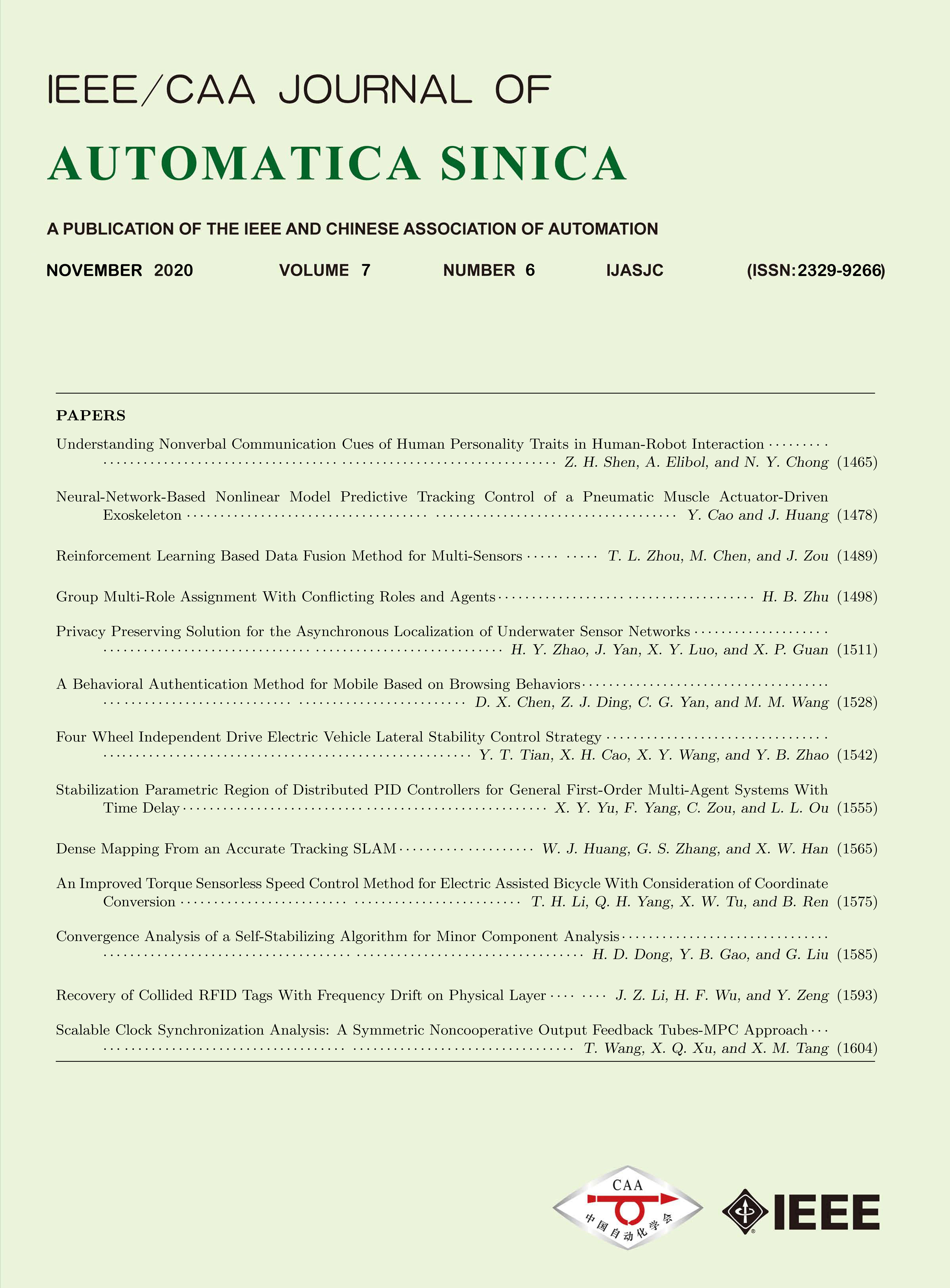 Volume 7
Issue 6
Volume 7
Issue 6
IEEE/CAA Journal of Automatica Sinica
| Citation: | Junzhi Li, Haifeng Wu and Yu Zeng, "Recovery of Collided RFID Tags With Frequency Drift on Physical Layer," IEEE/CAA J. Autom. Sinica, vol. 7, no. 6, pp. 1593-1603, Nov. 2020. doi: 10.1109/JAS.2019.1911720 |

| [1] |
X. Tan, H. Wang, L. Z. Fu, J. Y. Wang, H. Min, and D. W. Engels, “Collision detection and signal recovery for UHF RFID systems,” IEEE Transa. Autom. Science and Engineering, vol. 15, no. 1, pp. 239–250, 2016.
|
| [2] |
L. Zhang, W. Xiang, and X. Tang, “An adaptive anticollision protocol for large-scale rfid tag identification,” Wireless Comm. Letters IEEE, vol. 3, no. 6, pp. 601–604, 2014. doi: 10.1109/LWC.2014.2359461
|
| [3] |
H. F. Wu, Y. Zeng, J. H. Feng, and Y. Gu, “Binary tree slotted ALOHA for passive RFID tag anticollision,” IEEE Trans. Parallel and Distributed Systems, vol. 24, no. 1, pp. 19–31, 2013. doi: 10.1109/TPDS.2012.120
|
| [4] |
M. Shao, X. F. Jin, and L. B. Jin. An improved dynamic adaptive multi-tree search anti-collision algorithm based on RFID. in Proc. Int Conf. Data Science and Advanced Analytics, Shanghai, China: IEEE, pp. 72–75, 2015.
|
| [5] |
H. F. Wu and Y. Zeng, “Bayesian tag estimate and optimal frame length for anti-collision ALOHA RFID system,” IEEE Trans. Autom. Science and Engineering, vol. 7, no. 4, pp. 963–969, 2010.
|
| [6] |
M. Mayer and N. Goertz, “RFID tag acquisition via compressed sensing: Fixed vs. random signature assignment,” IEEE Trans. Wireless Communications, vol. 15, no. 3, pp. 2118–2129, 2016. doi: 10.1109/TWC.2015.2498922
|
| [7] |
J. S. Han, C. Qian, P. L. Yang, D. Ma, Z. P. Jiang, W. Xi, and J. Z. Zhao, “Geneprint: Generic and accurate physical-layer identification for UHF RFID tags,” IEEE/ACM Trans. Networking, vol. 24, no. 2, pp. 846–858, 2016. doi: 10.1109/TNET.2015.2391300
|
| [8] |
M. Benbaghdad, B. Fergani, and S. Tedjini, “Toward a new phy layer scheme for decoding tags collision signal in UHF RFID system,” IEEE Comm. Letters, vol. 20, no. 11, pp. 2233–2236, 2016. doi: 10.1109/LCOMM.2016.2601321
|
| [9] |
Y. Q. Zheng and M. Li, “P-mti: Physical-layer missing tag identification via compressive sensing,” IEEE/ACM Trans. Networking, vol. 23, no. 4, pp. 1356–1366, 2015. doi: 10.1109/TNET.2014.2326460
|
| [10] |
P. Ishwerya, V. N. Kumar, and G. Lakshminarayanan. An efficient digital baseband encoder for short range wireless communication applications. in Proc. Int. Conf. Electrical, Electronics, and Optimization Techniques, Chennai, India: IEEE, pp. 2775–2779, 2016.
|
| [11] |
F. Zhu, B. Xiao, J. Liu, and L. J. Chen, “Efficient physical-layer unknown tag identification in large-scale RFID systems,” IEEE Trans. Comm., vol. 65, no. 1, pp. 283–295, 2017.
|
| [12] |
X. Yang, H. F. Wu, Y. Zeng, and F. Gao, “Captureaware estimation for the number of RFID tags with lower complexity,” IEEE Comm. Letters, vol. 17, no. 10, pp. 1873–1876, 2013. doi: 10.1109/LCOMM.2013.082413.130765
|
| [13] |
J. Kaitovic and M. Rupp. RFID physical layer collision recovery receivers with spatial filtering. in Proc. IEEE Int. Conf. RFID Technology and Applications, IEEE, pp. 39–44, 2015.
|
| [14] |
M. Benbaghdad, B. Fergani, S. Tedjini, and E. Perret. Simulation and measurement of collision signal in passive UHF RFID system and edge transition anti-collision algorithm. in Proc. RFID Technology and Applications Conf., Tampere, Finland: IEEE, pp. 277–282, 2014.
|
| [15] |
F. Ricciato and P. Castiglione, “Pseudo-random aloha for enhanced collision-recovery in RFID,” IEEE Comm. Letters, vol. 17, no. 3, pp. 608–611, 2013. doi: 10.1109/LCOMM.2013.011513.122109
|
| [16] |
Y. X. Hou, J. J. Ou, Y. Q. Zheng, and M. Li, “Place: Physical layer cardinality estimation for largescale RFID systems,” IEEE/ACM Trans. Networking, vol. 24, no. 5, pp. 2702–2714, 2016. doi: 10.1109/TNET.2015.2481999
|
| [17] |
D. W. Shen, G. Woo, D. P. Reed, A. B. Lippman, and J. Y. Wang. Separation of multiple passive RFID signals using software defined radio. in Proc. IEEE Int. Conf. RFID, Orlando, FL, USA: IEEE, pp. 139–146, 2009.
|
| [18] |
K. Fyhn, R. M. Jacobsen, P. Popovski, A. Scaglione, and T. Larsen, “Multipacket reception of passive UHF RFID tags: A communication theoretic approach,” IEEE Trans. Signal Processing, vol. 59, no. 9, pp. 4225–4237, 2016.
|
| [19] |
C. Angerer, R. Langwieser, and M. Rupp, “RFID reader receivers for physical layer collision recovery,” IEEE Trans. Communications, vol. 58, no. 12, pp. 3526–3537, 2010. doi: 10.1109/TCOMM.2010.101910.100004
|
| [20] |
H. J. Duan, H. F. Wu, and Y. Zeng, “Channel estimation for recovery of UHF RFID tag collision on physical layer,” J. Electronics and Information Technology, pp. 1–5, 2016.
|
| [21] |
EPC radio frequency identity protocols class-1 generation-2 UHF RFID protocol for communications at 860 MHz−960 MHz. 2013.
|
| [22] |
M. Benbaghdad, B. Fergani, and S. Tedjini, “Backscatter signal model of passive UHF RFID tag. application to collision detection,” Electronics Letters, vol. 52, no. 11, pp. 974–976, 2016. doi: 10.1049/el.2015.3974
|
| [23] |
J. J. Ou, M. Li, and Y. Q. Zheng. Come and be served: Parallel decoding for COTS RFID tags. in Proc. Int. Conf. Mobile Computing and Networking, pp. 500–511, 2015.
|
| [24] |
P. Hu, P. Zhang, and D. Ganesan, “Laissez-faire: Fully asymmetric backscatter communication,” ACM SIGCOMM Computer Comm. Review, vol. 45, no. 4, pp. 255–267, 2015.
|
| [25] |
A. Bletsas, J. Kimionis, A. G. Dimitriou, and G. N. Karystinos, “Single-antenna coherent detection of collided fm0 RFID signals,” IEEE Trans. Comm., vol. 60, no. 3, pp. 756–766, 2012. doi: 10.1109/TCOMM.2011.020612.110212
|
| [26] |
S. O. Haykin. Neural Networks and Learning Machines. Pearson Schweiz Ag, 2009.
|
| [27] |
J. Z. Li, H. F. Wu, Y. Zeng, and Y. Shen. FM0 decode for collided RFID tag signals with frequency drift. in Proc. 2nd Int. Conf. Image, Vision and Computing, Chengdu, China: IEEE, pp. 941–945, 2017.
|